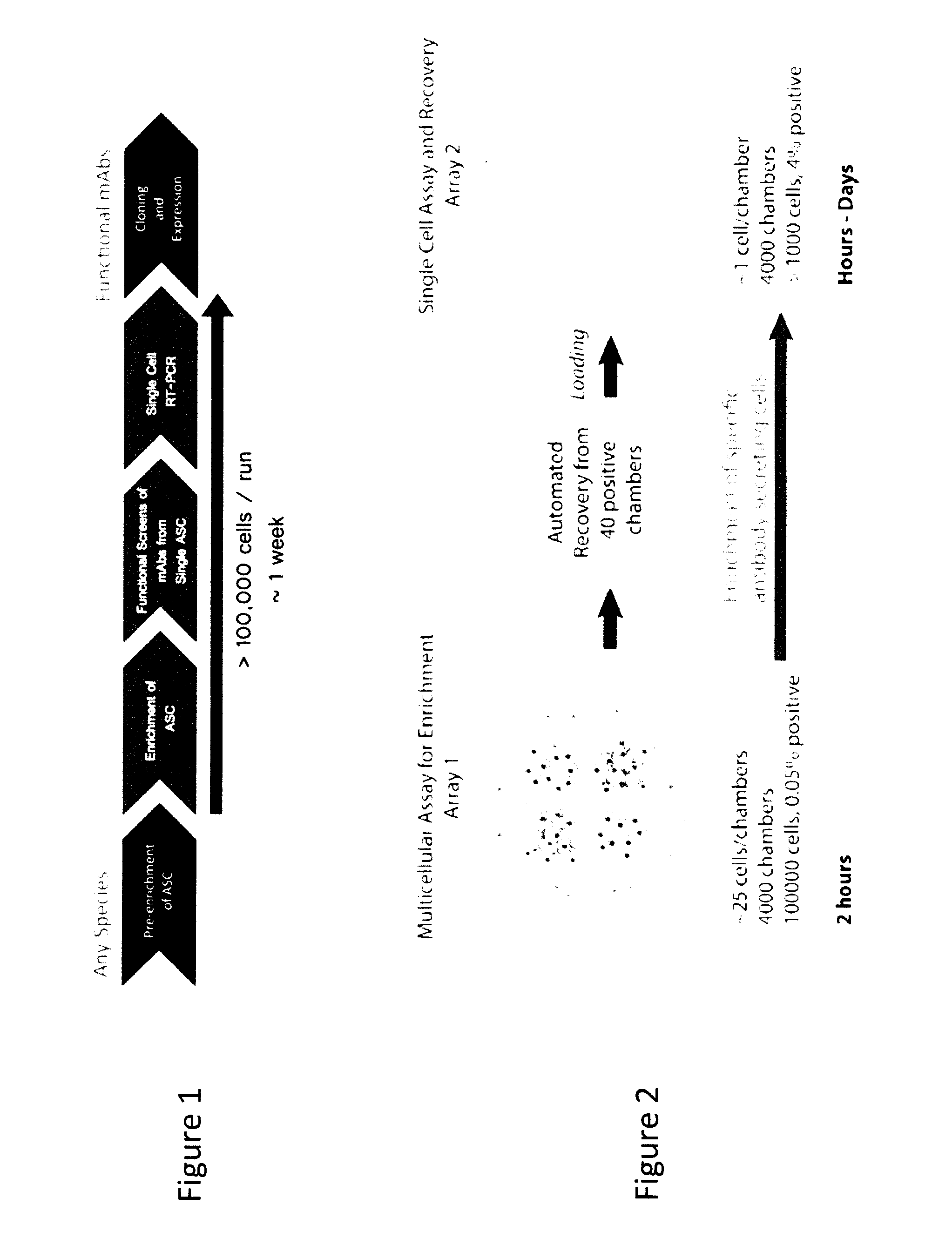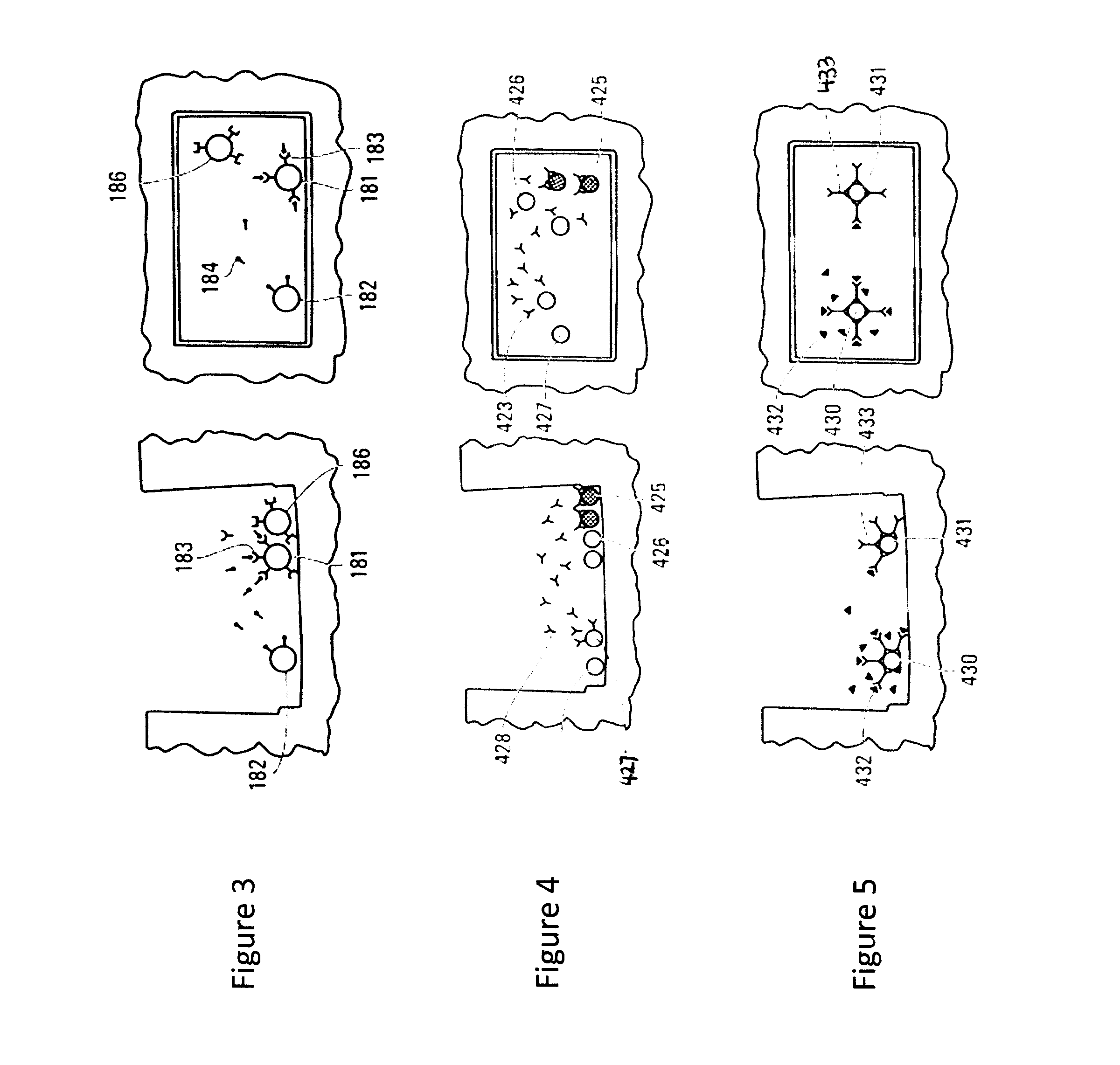Microfluidic Devices and Methods for Use Thereof in Multicellular Assays of Secretion
a technology of microfluidic devices and secretion, which is applied in the direction of instruments, peptides, laboratory glassware, etc., can solve the problems of poor reflected internal state of the majority of cells in the population, blurred process dynamics, and inadequate averaged measurements
- Summary
- Abstract
- Description
- Claims
- Application Information
AI Technical Summary
Benefits of technology
Problems solved by technology
Method used
Image
Examples
example 1
Fabrication of Microfluidic Devices
[0507]Microfluidic devices were fabricated using the protocol described in Lecault et al. (2011). Nature Methods 8, pp. 581-586 or an adapted version of this protocol (e.g., modified baking times or curing protocols) to obtain multiple layers including, from the bottom glass slide to the top: a flow chambers, a control layer, a membrane, and bath layer (FIG. 27). A cross-section of a device and a corresponding 3D-schematic of the chambers, flow channels and control channels are shown in FIG. 61 and FIG. 62, respectively. As described herein, where a control channel crosses a flow channel, a pinch valve is formed, and closed by pressurizing the control channel. A cover layer was added in certain instances to close the bath, or left omitted for an open bath such as the one shown in the device on FIG. 63.
example 2
Microfluidic Device for Cell Enrichment by Selection and Reinjection
[0508]The microfluidic device shown in FIG. 63 was used to implement an effector cell (antibody secreting cell) selection assay with reinjection capabilities for enrichment. As shown in FIG. 64, the device includes six inlet ports 1030, six control ports 1031 for controlling each inlet, four reinjection ports, one of which is 1032 and a single output port 1033. The device contains an array of 8192 identical unit cells, one of which is depicted in FIG. 2B and FIG. 61. Each unit cell contains a chamber which is 100 μm in width, 160 μm in length and 160 μm in height. Each chamber has a volume of about 2.6 nL. The device is divided into four sub-arrays, one of which is indicated by 1032 (FIG. 64). Each sub-array contains 2048 of the 8192 total unit cells. Each sub-array has its own sub-array valve 1034, which allows each sub-array to be fluidically addressed independently of the other sub-arrays. Each sub-array has a si...
example 3
Microfluidic Device for Segregation of Effector and Readout Cells
[0509]A microfluidic device was designed to permit readout cells to be kept in separate, isolated chambers from effector cells and to allow the contents of these chambers to be mixed on demand when needed. This configuration is used to implement effector cell assays, for example, cytokine neutralization assays. The architecture is particularly useful to prevent an effector cell's secretion product (e.g., antibody) from being completely washed away when the chamber comprising the effector cell(s) is perfused with a fluid, for example, when provided with fresh culture medium to maintain viability over extended periods of time. This configuration is also amenable if it is useful to limit the time during which the effector cell(s) is exposed to the medium conditions required for the extracellular effect assay (e.g., when a toxic cytokine is used as an accessory particle).
[0510]As shown in FIG. 65, this device consists of s...
PUM
| Property | Measurement | Unit |
|---|---|---|
| diameter | aaaaa | aaaaa |
| time | aaaaa | aaaaa |
| time- | aaaaa | aaaaa |
Abstract
Description
Claims
Application Information
 Login to View More
Login to View More - R&D
- Intellectual Property
- Life Sciences
- Materials
- Tech Scout
- Unparalleled Data Quality
- Higher Quality Content
- 60% Fewer Hallucinations
Browse by: Latest US Patents, China's latest patents, Technical Efficacy Thesaurus, Application Domain, Technology Topic, Popular Technical Reports.
© 2025 PatSnap. All rights reserved.Legal|Privacy policy|Modern Slavery Act Transparency Statement|Sitemap|About US| Contact US: help@patsnap.com



